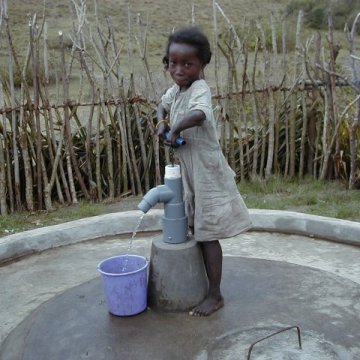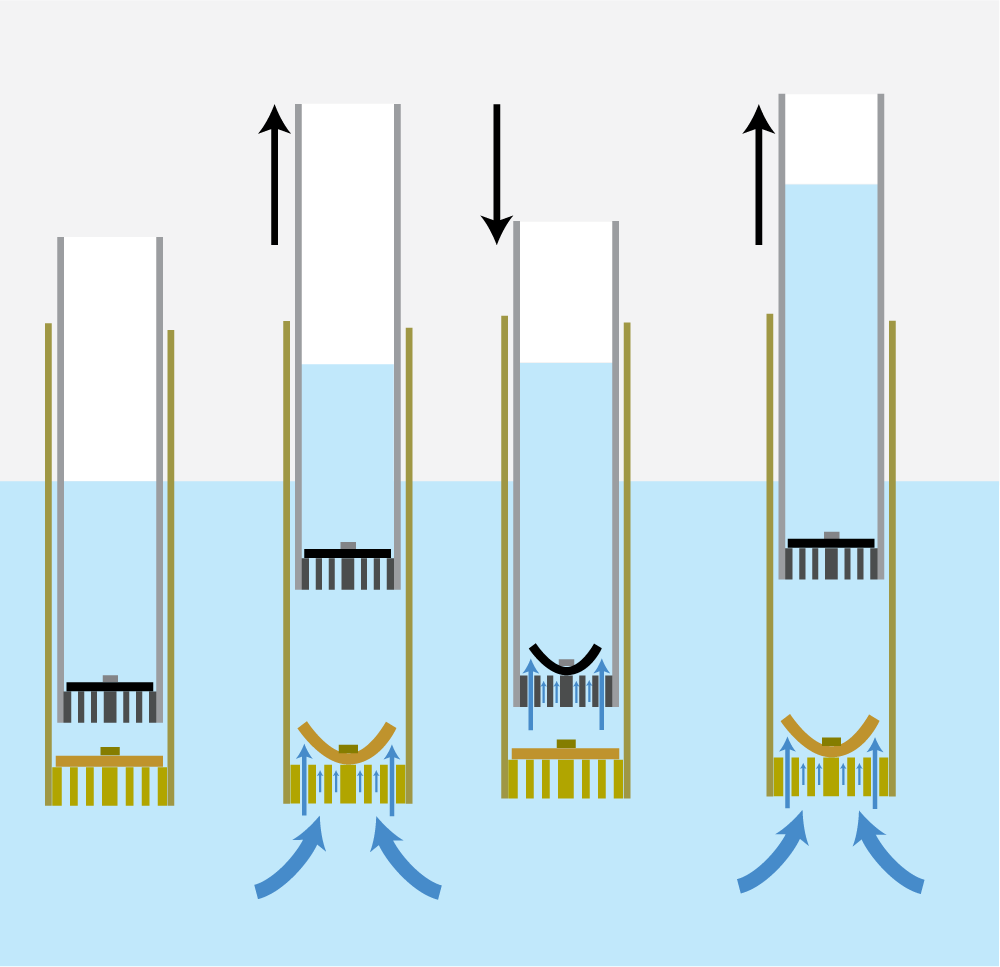Difference between revisions of "Canzee pump"
| Line 1: | Line 1: | ||
__NOTOC__ | __NOTOC__ | ||
[[Image:Canzee pump.gif|thumb|right|300px|Canzee pump]] | [[Image:Canzee pump.gif|thumb|right|300px|Canzee pump]] | ||
| − | [[Image:Canzee pump2. | + | [[Image:Canzee pump2.jpg|thumb|right|300px|Canzee pump]] |
The Canzee hand pump is a direct-action handpump made with corrosion resistant materials such as plastic, stainless steel and wood. The pump uses two PVC pipes inside each other, each with a simple non-return valve made with a rubber flap. | The Canzee hand pump is a direct-action handpump made with corrosion resistant materials such as plastic, stainless steel and wood. The pump uses two PVC pipes inside each other, each with a simple non-return valve made with a rubber flap. | ||
Revision as of 00:41, 4 May 2012
The Canzee hand pump is a direct-action handpump made with corrosion resistant materials such as plastic, stainless steel and wood. The pump uses two PVC pipes inside each other, each with a simple non-return valve made with a rubber flap.
The Canzee pump was first developed in New Zealand by Owen Jones, and was further developed by Richard Cansdale of SWS Filtration in the UK. Organisations that work with the Canzee pump include Bushproof and Wells for Zoë. The pump is extensively used in Madagascar.
Suitable conditions
The Canzee pump is suitable for use in shallow wells and underground tanks. It pumps from at least 10 meters, and pumps about 20 liters per minute.
| Advantages | Disadvantages/limitations |
|---|---|
| - Fast and easy installation - Easy operation, also for smaller children |
- Maximal water lifting capacity is 12 to 15 m - Designed as family pump for
serving user groups of about 100 to 150 people |
Construction, operations and maintenance
The pump consists of two PVC pipes of different diameter, one inside the other. At the bottom of each pipe is a non-return valve made with a rubber flap which allows water to enter the bottom of the pipe, but not out again.
Except for the pump handle and the stainless steel pump rod, the Canzee Pump is made almost totally of plastic. The pump head is made from the extremely strong plastic ABS, which is UV resistant.
The down hole components such as the rising main and pump rod pipes are made of standard PVC-U pipes used for drinking water, and the plunger and footvalves are machined from Polyamide. The only non-plastic components are the pumprod (stainless steel) the pump handle (local hardwood) and a number of bolts, nuts and washers (galvanized steel), which are not in direct contact with the water pumped. The Canzee Pump is totally corrosion resistant because all materials used are either of plastic, wood or stainless steel.
The pump head, handle and rod weigh 3.0 kilos, while the combined weight of the two pipes is 1.0 kilos per metre. A complete pump kit, capable of lifting from a depth of seven metres, weighs about 10 kilos and is packed in packages no more than 2.0 metres long.
For assembling complete pumps, minimal tools and connecting fixture are required for jointing the plastic components by gluing (ABS) and solvent cementing (PVC-U components). Two bags of cement are required to make a proper pump stand with platform and drainage channel.
As the inner pipe is lifted, the water in it is also lifted. When the pipe is lowered, more water is forced into it from the bottom. This process continues until water starts to flow from the pump head.
Currently, the Canzee pump is manufactured by BushProof in Madagascar.
The design of the pump allows in principle for local manufacture, although the availability of the ABS plastic and polyamide for the washers could be a limiting factor.
Maintenance
The Canzee Pump is designed so that maintenance is very easy and understandable for the pump users. Only one spanner and one nail are required to dismantle the whole pump. The down hole components can be cleaned, checked and re-installed in a short time, and because the PVC pipes are light, little force for lifting and tightening is required.
The Canzee Pump’s design has eliminated the need for piston seals (cup seals) The non-return valves at the bottom of each pipe use a rubber disc which can be cut from an old tyre inner tube of a car tire. Since the two pipes are separated by a water film there is very little wear between them. In case of a problem, a short length of worn pipe can easily be cut out and replaced. One Canzee pump serving in a clinic in Uganda and used by more than 200 people every day, only needed one of the two rubber discs to be changed in over two and a half years.
Small repairs can be made at low cost, and will mainly involve purchase of some solvent cement for connecting pipes, replacing pipe parts, and replacing pump handles, which can be locally produced. Other maintenance, such as the provision of a rope to stop excessive handle movement and the washing of down hole components, can been carried out by the users at no cash cost.
The MEDAIR programme in Madagascar 1 is the first programme to use the Canzee Pump on a large scale, and its long-term performance in the field must be evaluated over the coming years.
Suppliers
- BushProof, Madagascar
- SWS Filters
Costs
For the specific Maroantsetra installations project in Madagascar, MEDAIR has evaluated the installation costs. According to the National Director, Christophe Roduit, pump purchase including transport costs from England to Maroantsetra, administrative support and installation, their total investment was around 700 Euro per pump installed in Maroantsetra (this price includes the pump cost of 310 Euro and the extra cost for the larger apron).
The pump users contributed with delivering of materials (gravel and sand) and provided labour. Because of the emergency nature of the project and the rapid and simple installation methods used, the beneficiary contribution was small in financial terms.
Field experiences
The Canzee pump is used in Madagascar, where hundreds of pumps have already been installed. Canzee pumps have also been used for years in Kenya, Ecuador, Israel, Morocco, Zimbabwe, Angola and other countries.
In the field, performance of the pump has been verified in several countries. Kenyan users report 3 years of continued use by 200 people, lifting water from 6 meters, before having to repair the rubber flap. In Uganda 2 years and 8 months passed before the first repair. In Madagascar, village pumps have continued to operate without breakdown for more than 2 years as well.2
The NGO MEDAIR has been active in Madagascar since 2002, and is the first to have installed a large number of Canzee pumps. They worked in the Maroantsetra region in Madagascar in hydrogeologically suitable communities in the rural areas. They found that in previous projects, not enough attention was paid to environmental issues. Especially in the context of installation in shallow wells, more careful siting is needed. 3
Reference manuals, videos, and links
- Wells for Zoë has developed a movie about experiences with the Canzee pump in Madagascar
- Movie by Bushproof on the Canzee pump
- Bush Proof article about Canzee pumps.
- SWS Filtration Limited, the company of Richard Cansdale.


